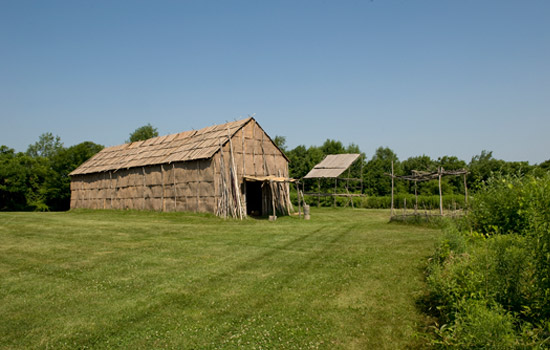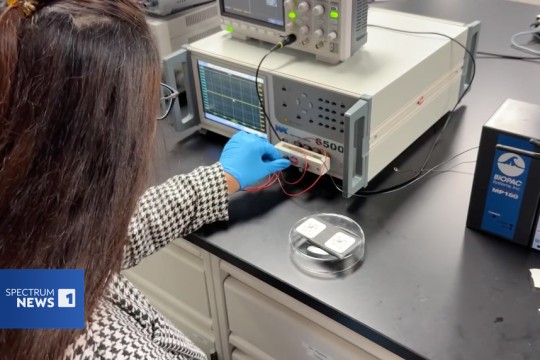RIT Named to List of Top 200 Colleges for Native Americans
University cited for educational, research and cultural programming
A. Sue Weisler
A replica of a traditional Iroquois long house, pictured above, is a centerpiece of the Ganondagan State Historic Site in Victor, Ontario County. RIT’s partnership with the cultural center is one of several research and education initiatives that helped the university earn selection as one of America’s top 200 colleges for Native Americans.
Rochester Institute of Technology is being recognized as one of the nation’s best educational choices for Native American students. The American Indian Science and Engineering Society has named RIT as one of America’s Top 200 Colleges for Native Americans.
The list appears in the society’s 2010-2011 College Guide, which features RIT student Wuttachki Myles, a third-year mechanical engineering technology major and member of the Navajo Tribe, on the cover. The publication also profiles RIT as one of eight model universities for Native American engagement.
“We are proud to be considered a model university for Native American student engagement,” RIT President Bill Destler says. “RIT is committed to improving graduation rates and the college experience for Native scholars, while also promoting the tremendous Native American culture and history present in upstate New York.”
RIT’s efforts to improve educational opportunities for Native Americans and its research and education programming in the field led to the recognition.
The university’s initiatives include the Native American Future Stewards Program, which offers academic and social support to Native American, Alaska Native and First Nations students. It seeks to enhance retention and increase the number of Native Americans attending and graduating from college. The program currently serves close to 70 RIT students who represent 26 tribes from across the country.
RIT also has a research and education partnership with the Ganondagan State Historic Site in Victor, Ontario County, a museum and resource center promoting the culture and history of tribes of the Iroquois Confederacy. The effort seeks to enhance opportunities for Native American students and promote the benefits of indigenous technologies.
In addition to these activities, RIT has formed a Native American Advisory Council including leaders from the Iroquois Tribes and government officials from the state and local level. The council will assist the administration in increasing opportunities for Native American students and expanding partnership opportunities between the university and New York’s Native American communities.
“Across the nation, Native Americans have one of the lowest college graduation rates of any racial or ethnic group, yet here at RIT we graduate almost all of our scholars in the Future Stewards program,” notes Jason Younker, associate professor of anthropology and Future Stewards coordinator.
“Through the advisory council, the Future Stewards initiative and efforts such as our Ganondagan partnership, RIT is working to improve educational opportunities and ultimately the quality of life for Native Americans both here in Rochester and throughout the country,” adds Kevin McDonald, RIT chief diversity officer.
The American Indian Science and Engineering Society, founded in 1977, has worked to remove barriers to fuller representation and participation in the science, technology, engineering and math disciplines among Native people¬—as students, professionals, mentors and leaders. The organizations annual college guide features information on cultural offerings and educational and research programming at colleges and universities throughout the country.
Note: Founded in 1829, RIT is an internationally recognized leader in professional and career-oriented education enrolling more than 15,200 students. In U.S. News and World Report: Best Colleges and Universities 2011, RIT ranks seventh in the “Best Universities – Master’s (North region)” category. The university is also featured as one of the nation’s best institutions for undergraduate education in The Princeton Review’s annual guide, The Best 373 Colleges and is included in the 2011 edition of The Fiske Guide to College, which features more than 300 of the country’s best and most interesting colleges and universities.













